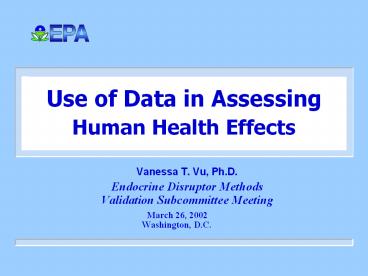Use of Data in Assessing Human Health Effects PowerPoint PPT Presentation
1 / 20
Title: Use of Data in Assessing Human Health Effects
1
Use of Data in Assessing Human Health Effects
- Vanessa T. Vu, Ph.D.
- Endocrine Disruptor Methods
Validation Subcommittee Meeting - March 26, 2002
- Washington, D.C.
2
Objectives
- Describe ongoing activities addressing human
relevancy - Overview of EPAs current approach to human
health risk assessment - Focus on data used in Hazard and Dose-Response
Assessment - Discuss the need for further work
3
EPA Risk Assessment Guidelines
- Provide guidance to the Agency and inform outside
parties how risk assessments are to be conducted
to foster sound science, consistency, and
transparency - Lay out scientific principles, approaches,
processes, and procedures for conducting human
health and ecological hazards and risks - Guidance for data interpretation, and use of data
4
EPA Human Health Risk Assessment Guidelines
- Specific Health Effects
- Carcinogenicity (1986, 1999)
- Neurotoxicity (1998)
- Reproductive toxicity (1996)
- Developmental toxicity (1991)
- Mutagenicity (1986)
- Others
- RfC (1994), Benchmark Dose (2000),
- Chemical Mixtures (1986, 2001)
- Risk Characterization (2000)
- Exposure Assessment (1996)
5
Risk Assessment ProcessHuman Health
HAZARDASSESSMENT
DOSE RESPONSE ASSESSMENT
EXPOSURE ASESSMENT
Dose-Response Characterization
Exposure Characterization
Hazard Characterization
Risk Characterization Summary
Integrative Analysis
Risk Characterization Process
6
Current Approach
- Emphasize full characterization and integration
- Maximum use of all relevant information
- Expand role of mode of action information
- Harmonized approaches for all toxicities
- Two-step dose response assessment
- Evaluate data in range of observation
- Evaluate in range of human exposure
(extrapolation)
7
Data Used in Hazard and Dose Response Assessment
- Studies of humans
- Data from other species
- Standard screening and toxicity studies
- Toxicokinetic and metabolic studies
- Mode of action information
- Other relevant information, e.g., chemical and
physical properties, SAR
8
Major Default Assumptions
- In the absence of adequate human data
- An agent that produce an adverse effect in
experimental animal studies is assumed to pose a
hazard to humans and - Data from the most appropriate or sensitive
species should be used - In the absence of mode of action information
- A linear dose response curve is assumed for
carcinogenic effects - A nonlinear dose response (or threshold) is
assumed for other effects
9
Mode of Action
- How does the agent produce its effect?
- Are there data to support a postulated mode of
action? - Have other modes of action been considered and
rejected?
10
Mode of Action vs.Mechanism of Action
- Mode of Action
- Key events and processes, starting with the
interaction of an agent with a cell, through
functional and anatomical changes, resulting in
toxicity - Mechanism of Action
- Detailed molecular description of a key event in
the induction of toxicity
11
Use of Mode of Action Information
- Evaluate relevance of animal models
- Determine relative sensitivity of animal models
compared to humans - Identify susceptible subpopulations and estimate
variability in response - Refine measures of dose and response
12
Use of Mode of Action Information (continued)
- Strengthen inferences regarding the shape of dose
response curves outside the range of observation - Provide the basis for an integrated approach for
all health endpoints - Extrapolate within chemical classes with common
mode(s) of action
13
Demonstrating a Mode of Action
- To show that a postulated mode of action is
operative, it is generally necessary to - Outline the sequence of events leading to effects
- Identify key events that can be measured
- Weigh information to determine whether there is a
causal relationship between events and toxic
effects
14
Key Event-- Examples
- Metabolism
- Receptor-ligand changes
- DNA or chromosome effects
- Increased cell growth and organ weight
- Hormone or other physiological
perturbations - Hyperplasia, cellular proliferation
15
Use of Mode-of-Action Information Examples
- Formaldehyde DNA crosslinks
Cell proliferation - d-Limonene ?2u-globulin
- Chloroform Cytotoxicity
- Dioxin Receptor-mediated responses
- Perchlorate Altered thyroid homeostasis
- Vinyl acetate Cytotoxicity
Cell proliferation
16
Current ActivitiesCarcinogenicity
- Framework for evaluating mode of action has been
developed for carcinogenic effect (IPCS, 2000) - Several activities are underway to provide
additional guidance for evaluating the relevance
of the animal mode of action to humans - EPA-- Finalize EPAs Carcinogen Risk Assessment
Guidelines - ILSI-RSI, WHO/IPCS
17
Current Activities (continued)
- Review of available data for pharmaceuticals to
determine similarities and differences between
animals and humans - Concordance of toxicity (ILSI-HESI)
- Pharmacokinetics (EPA)
18
Endocrine DisruptionEPA Interim Policy
- Based on the current state of science, the
Agency does not consider endocrine disruption to
be an adverse endpoint per se, but rather a mode
or mechanism of action potentially leading to
other outcomes, for example, carcinogenic,
reproductive or developmental effects, routinely
considered in reaching regulatory decisions.
Evidence of endocrine disruption alone can
influence priority setting for further testing
and the assessment of the results of this testing
could lead to regulatory action if adverse
effects are shown to occur. This position could
change as additional data become available on the
mechanisms and role of endocrine disruptors. - Special Report on Environmental Endocrine
Disruption An Effects Assessment and Analysis
(1997)
19
Planned Activities on Endocrine Disruptors
- Case studies demonstrating an integrated approach
for using all available data to assess effects in
humans and wildlife species (EPA) - Framework for Risk Assessment of EDCs (EPA)
- Review of pesticides with common modes of action-
anti-thyroid, anti-androgen compounds (EPA)
20
Future Needs
- Continued research and evaluation of the modes of
toxic action in animals and human relevancy - Endocrine disruption modes of action
- Demonstrate the usefulness of a framework to
evaluate modes of action for non-cancer
toxicities and human relevancy

